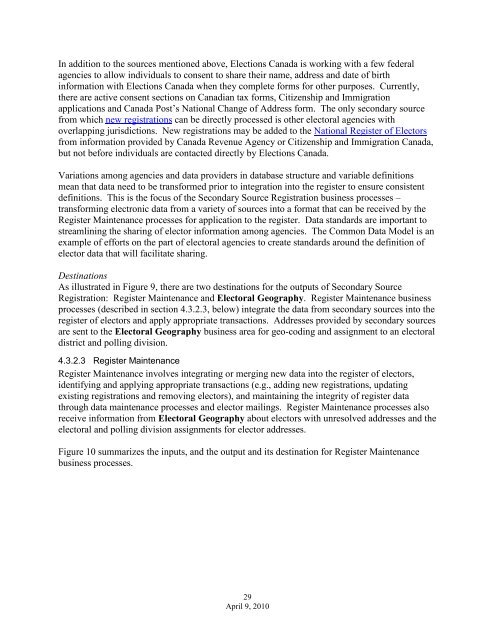Electoral-Management-Reference-Model-v.1.0
Electoral-Management-Reference-Model-v.1.0
Electoral-Management-Reference-Model-v.1.0
Create successful ePaper yourself
Turn your PDF publications into a flip-book with our unique Google optimized e-Paper software.
In addition to the sources mentioned above, Elections Canada is working with a few federal<br />
agencies to allow individuals to consent to share their name, address and date of birth<br />
information with Elections Canada when they complete forms for other purposes. Currently,<br />
there are active consent sections on Canadian tax forms, Citizenship and Immigration<br />
applications and Canada Post’s National Change of Address form. The only secondary source<br />
from which new registrations can be directly processed is other electoral agencies with<br />
overlapping jurisdictions. New registrations may be added to the National Register of Electors<br />
from information provided by Canada Revenue Agency or Citizenship and Immigration Canada,<br />
but not before individuals are contacted directly by Elections Canada.<br />
Variations among agencies and data providers in database structure and variable definitions<br />
mean that data need to be transformed prior to integration into the register to ensure consistent<br />
definitions. This is the focus of the Secondary Source Registration business processes –<br />
transforming electronic data from a variety of sources into a format that can be received by the<br />
Register Maintenance processes for application to the register. Data standards are important to<br />
streamlining the sharing of elector information among agencies. The Common Data <strong>Model</strong> is an<br />
example of efforts on the part of electoral agencies to create standards around the definition of<br />
elector data that will facilitate sharing.<br />
Destinations<br />
As illustrated in Figure 9, there are two destinations for the outputs of Secondary Source<br />
Registration: Register Maintenance and <strong>Electoral</strong> Geography. Register Maintenance business<br />
processes (described in section 4.3.2.3, below) integrate the data from secondary sources into the<br />
register of electors and apply appropriate transactions. Addresses provided by secondary sources<br />
are sent to the <strong>Electoral</strong> Geography business area for geo-coding and assignment to an electoral<br />
district and polling division.<br />
4.3.2.3 Register Maintenance<br />
Register Maintenance involves integrating or merging new data into the register of electors,<br />
identifying and applying appropriate transactions (e.g., adding new registrations, updating<br />
existing registrations and removing electors), and maintaining the integrity of register data<br />
through data maintenance processes and elector mailings. Register Maintenance processes also<br />
receive information from <strong>Electoral</strong> Geography about electors with unresolved addresses and the<br />
electoral and polling division assignments for elector addresses.<br />
Figure 10 summarizes the inputs, and the output and its destination for Register Maintenance<br />
business processes.<br />
29<br />
April 9, 2010


